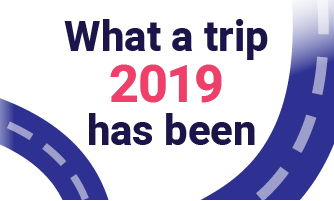Roster optimization can drive efficiencies, save pay time and improve driver satisfaction. Most importantly, it reduces the ratio of overtime/total paid time, potentially saving 2-5% of all labor-related operating expenses. Rosters also have a profound impact on operators: how many routes they drive, start times, days off, a 4-day or 5-day workweek and more. It’s important to devote resources to rosters and to use technology to optimize them.
But before we go into how agencies and operators can realize these benefits, let’s look at some definitions and how to compare different roster scenarios.
What is roster optimization?
Rosters are the last optimization step (in the planning stage). First you need to define routes and timetables, then come vehicle and crew scheduling (blocking and runcutting) and only then can rosters be optimized. Since they are last in line, and since the preceding steps require a considerable effort, many people ignore the benefits that can be delivered through roster optimization.
Rostering is the process of grouping daily operator runs into packages of (typically) weekly work assignments, including a mixture of runs such as weekday only, weekdays and a Saturday or Sunday, etc.
A balancing act
Creating rosters is a balancing act between competing requirements as follows:
- Compliance with regulations and collective bargaining agreements. This relates to issues such as the number of days worked, minimum/maximum weekly (or period) hours, days off requirements, minimum rest breaks, run type limitations, etc.
- Safety requirements, mostly relating to time off between duties/runs
- Operational efficiency, such as reducing pay hours, overtime, guaranteed time or number of operators
- Driver preferences, such as days off patterns, types of runs operated, rest breaks, and other working conditions
To better understand the interplay of those elements, it is best to create several roster scenarios, optimizing for different needs – and to compare the KPIs for each scenario as well as other operational needs. A good method for the comparison is to compare the following, for each scenario:
- overtime
- make up (guaranteed) time
- pay hours; and
- number of rosters.
To illustrate the discretion required in choosing amongst scenarios, let’s consider overtime. Is overtime necessarily bad? The answer is that it isn’t always bad – overtime can result in a need for fewer operators and help deal with driver shortages. On the other hand, it shouldn’t get out of hand and create safety concerns.
The importance of roster groups
Roster groups are the practice of creating different types of rosters for different groups of drivers, based on the same schedule. Using Optibus, you can even create different preferences for different groups, to reflect ongoing practices or collective bargaining agreements.
Here are some examples of roster groups:
- Veteran drivers and new drivers
- Part-time drivers and full-time drivers
- 4-day and 5-day
- Drivers with varying union regulations
You can also play with the mix of duties – preferring some roster groups over others, or mix different duties to create better quality rosters for all.
Comparing scenarios in practice
Let’s look at different roster scenarios and preferences and how these can be compared and evaluated:
Let’s look at a scenario focused on overtime reduction:
| KPI | Current Schedule | Scenario 1 |
| Vehicles (PVR) | 55 | 55 |
| Roster Count | 115 | 115 |
| Over Time Hours | 58 | 0 |
The scenario here results in zero overtime hours, while keeping the same number of rosters, saving 1508 hours annually, which is approximately $37,000 a year. In the background, preferences and rules were set so that the number of routes in each route is kept low, while maintaining a similar start time for most rosters, for the benefit of the drivers. This was achieved by using the homogeneity preference in the roster module to maintain similar start times all week.
In addition, we adjusted the roster type so that the number of hours per duty is higher when the driver works fewer days per week and lower when the driver works more days per week – for instance, drivers with 5-day workweeks would work 8-hour shifts and drivers with 4-day workweeks would work 10-hour shifts.
The focus of the next scenario is reducing the amount of roster rows:
| KPI | Scenario 1 | Scenario 2 | Scenario 3 |
| Scenario | 0 Overtime | Minimum Number of Rosters | Start time similarity |
| Number of Rosters | 144 | 130 | 133 |
| Weekly Hours | 5312 | 5312 | 5312 |
| Over Time Hours | 0 | 119 | 160 |
| Over Time % | 0% | 2.2% | 3% |
| % of rosters with 90min start time difference | 65% | 75% | 92% |
| # of 4-day rosters | 134 | 76 | 68 |
| # of 5-day rosters | 4 | 54 | 57 |
| Part-Time Rosters | 6 | 0 | 8 |
- Scenario 1 focuses on zero overtime. It requires a total of 144 drivers, and most of them (134) have 4 day rosters (four-ten rostering). Another thing to note about this scenario is that 65% of the rosters in this scenario are with a maximum start time difference of 90 minutes, which results in a higher quality roster from the drivers’ point of view.
- Scenario 2 focuses on minimizing the number of rosters, resulting in 14 less rosters compared to scenario 1, yet adding 119 overtime hours. Allowing some overtime also resulted in more rosters to have a maximum start time difference of 90 minutes, which means higher quality rosters.
- Scenario 3: The focus of this scenario was to gain a better start time similarity. In this case, the trade-off was to increase the overtime to 3%, at 160 hours of overtime,
Other considerations, which we did not go into in these scenarios are limiting the number of short shifts are limiting route variations within rosters (typically the more limits, the higher the number of rosters). Is it important for an operator to work the same weekday run every day? Agencies supporting this view are willing to accept some additional cost in order to achieve route and passenger familiarity. At other agencies, operators may prefer the variety of working different runs or routes to relieve boredom (and the potential of related fatigue).
Summary
Roster optimization carries a lot of potential both in terms of efficiencies and driver satisfaction. Yet it’s important to remember that one size doesn’t fit all, and the best practice is to generate several scenarios and choose the best one, balancing between competing needs.
Additionally, working with roster groups can help optimize rosters for groups as well as create better quality rosters from the driver’s viewpoint.







